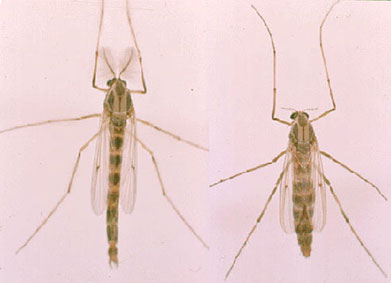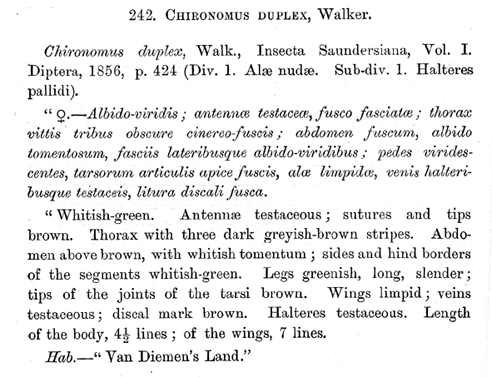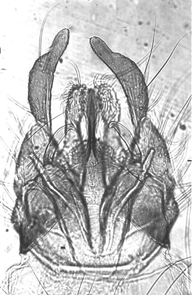C. duplex Walker, 1856 Synonyms:
C. imitans Walker, 1856 (see transcription of original description)In BOLD Bin: BOLD:AAM6665A large species with the anterior tarsi of the male strongly bearded; Leg ratio about 1.2-1.3.  
Original description of Chironomus duplex as repeated by Skuse (1889)Further information on type female: (This specimen was measured by Paul Freeman of the British Museum Natural History and later by me).
Wing length 7.40 mm, width 1.72 mm, VR 0.92.
Colour as in original description.
Cephalic tubercle 60 µm long. 47 clypeal setae. Only P2 could be measured, as 70 µm.
Available leg lengths (micron) and proportions:
| Fe
| Ti
| Ta1
| Ta2
| Ta3
| Ta4
| Ta5
| LR
| F/T
| PI
| 2080
| 2040
| -
| -
| -
| -
| -
| -
| 1.02
| PII
| 2280
| 2280
| -
| -
| -
| -
| -
| -
| 1.00
| PIII
| 2840
| 2880
| 1920
| 1080
| 840
| 480
| -
| 0.67
| 0.99
| Note: Holotype is a female. Since Freeman (1961) classed this species as a synonym of C. australis, the male has not been specifically described previously. Male:
Wing length about 4.8-6.3 mm; width 1.08-1.24 mm. VR about 1.02-1.07.
Antennal ratio (AR) about 3.81-4.75.
Frontal tubercles present, length about 44-73 micron; clypeus approximately triangular in shape, width about the same as diameter of antennal base (0.82-1.2 x); 29 - 55 clypeal setae.
Scutellum with setae in two rows; anterior with 11-23 setae (higher numbers generally in two rough rows), posterior with 15-23 setae.Leg lengths (microns) and proportions as follows:
| Fe
| Ti
| Ta1
| Ta2
| Ta3
| Ta4
| Ta5
| LR
| F/T
| BRTi
| PI
| 1745
| 1674
| 2105
| 1129
| 832
| 726
| 354
| 1.19-1.36
| 0.97-1.11
| 4.3-8.7
| PII
| 1894
| 1873
| 1065
| 662
| 504
| 358
| 263
| 0.51-0.65
| 0.97-1.07
|
| PIII
| 2335
| 2439
| 1584
| 966
| 738
| 472
| 281
| 0.56-0.70
| 0.82-1.01
|
| MidTi/AntTi - 1.10-1.16Abdomen black with a pale posterior margin on the anterior segments; about 4.8 (1-8) setae in a single patch at centre of tergite IX.
 Male terminalia of C. duplex Male terminalia of C. duplexSuperior volsella closest to E(h) type of Strenzke (1959); Inferior volsella reaching about to midpoint of the gonostylus, with simple setae; gonostylus moderately swollen and reducing sharply over about the posterior third; about 7-10 setae at distal end, usually termonating in a smaller, slightly separated seta. Female:
Wing length 5.76 (4.16-7.40 mm; width 1.64 (1.24-2.10 mm; VR 0.92-0.97. About 5.3 (4-7) SCf on brachiolum and 26.7 (18-38) setae in squamal fringe. LR about 1.30.
Colour much as in male, but abdomen somwhat darker although anterior margin pale.
Relative lengths of antennal segments (micron) and fraction of neck in brackets: 283 (0.25) : 138 (0.52) : 156 (0.40) : 152 (0.39) : 314; AR 0.46 (0.41-0.59); A5/A1 1.24 (1.18-1.29). Cephalic tubules quite variable in length often due to mounting variation, 23-76 µm (usually more than 50 µm) and about 1.3-3.0 times longer than width at base, seta usually lost. Clypeal width about 2.3 (1.6-3.0) times the diameter of the antennal base, about 50.2 (29-69) clypeal setae. Palpal proportions (micron) 81 : 81 : 281 : 296 : 418: P5/P4 1.11-1.98.
Thoracic setae: Acrostichals - about 16.3 (10-26); Humerals - 4.5 (4-6) in partial clump or linear; Dorsocentrals (incl. Humerals)33.6(29-43); Prealar - 7.7 (6-11); Supraalar - normally 1, occasionally 2; Scutellar in multiple rows - 19.7 (11-32) in 2-3 anterior rows; 21.7 (19-27) in posterior row (total 30-56).
Legs greenish, tips of tarsi dark brown.
Leg lengths and proportions (micron):
| Fe
| Ti
| Ta1
| Ta2
| Ta3
| Ta4
| Ta5
| LR
| F/T
| Ta4/TiTi
| PI
| 1872
| 1730
| 2237
| 1073
| 742
| 667
| 340
| 1.18-1.60
| 0.93-1.13
| 0.38-0.53
| PII
| 1997
| 1961
| 1050
| 645
| 468
| 344
| 274
| 0.49-0.78
| 0.95-1.08
|
| PIII
| 2356
| 2457
| 1614
| 993
| 775
| 472
| 317
| 0.58-0.68
| 0.86-1.02
|
| MidTi/AntTi - 1.07-1.16; BR about 0.80-2.29.Abdomen brown with pale anterior margins. Segment X relatively broad (192x76 µm; 2.53 times longer than greatest width) with 28-42 setae; cercus generally rounded with a large ventral bulge (which may lead to this margin being longer) and sometimes a smaller dorsal bulge, near the base. Morphologically very similar to C. occidentalis and C. australis (with which it was incorrectly but understanably synonymised by Freeman 1961), but is distributed allopatrically to the former and differs from the latter by the generally longer length of the femur and tibia of the mid and hind legs. ( A complex discriminant function formula that partially separates the two species was used by Martin (Ph.D. Thesis 1966)). The ratio of Mid femur/Ant femur = 1.08-1.17; Mid tibia/Ant tibia = 1.04-1.18; Hind femur/Ant femur = 1.25-1.45; Hind tibia/Ant tibia = 1.38-1.53.
It seems likely that a male with a mid femur >1.12 x the anterior femur will be C. duplex, and as well will have more setae, particularly on the clypeus (39.4 cf. 35.1). The values for females are lower and there is more overlap, but a value of 1.10 or above is likely to be C. duplex; as well Seg.X generally with more than 27 setae while females of C. australis (17-32) and C. occidentalis generally has less than 25. Also the ratio of fore Ta4/Ti (0.38-0.53) is lower than that of C. australis (0.50-0.56). Molecular data:
mt COI: see GenBank accession numbers AF192179, AF192210, KC750293-KC750303; and BOLD CAUS026-10
mt cytB: see GenBank accession numbers KC750721-KC750729.
gb2β: see GenBank accession numbers AJ003790, AJ003791.
γ-glutamylcysteine synthase: see GenBank accession number AY490748.
Ribosomal protein S26 (RpS26): see GenBank accession number AY490754.
glutathione synthase: see GenBank accession number AY490750.
CRT1-like SINE region: see GenBank accession numbers AF356441-AF356450. Found: New South Wales: Forbes (33.22.85°S, 148.00.66°E).
South Australia: Barmera (34.25°S, 140.47°E); Lake Edward & Lake Leake, Kalangadoo (37.62°S, 140.58°E); Brown Lake, & Valley
Lake, Mt. Gambier; Victor Harbor (37.80°S, 140.75°E).
Tasmania: Flinders Island - Stoney Lagoon and Babel Farm, Lackrana area (40.10°S, 148.22°E); Kronstadt Farm, Emita (40.00°S,
147.92°E); West End Farm, Leeka; abt. 13 Km n.w. Whitemark(39.87°S, 147.80°E).
King Island - Cape Wickham Rd., nr. Little Cask Lagoon (39.60°S, 143.93°E).
Lake Dulverton, Oatlands (42.28°S, 147.35°E).
Victoria: Albert Park, South Melbourne (37.85°S, 143.05°E); Lake Bullen Merri, Camperdown (38.25°S, 143.10°E); Snake Gully,
Monash University, Clayton (37.9083°S, 145.138°E); French Island (38.35°S, 145.38°E); Hoddles Creek; Lara (37.83°S, 144.33°E);
Lake Learmonth, Learmonth (37.43°S, 143.70°E); Leslie Manor (abt 38.17°S, 143.50°E); Royal Botanical Gardens, Melbourne
(37.83°S, 144.00°E); Edwardes Lake, Reservoir (37.42.77°S, 144.59.67°E); Emu Bottom, Sunbury (37.53°S, 144.73°E); 7 Km s.
Wangaratta (36.44°S, 146.25°E); Melbourne Water Metropolitan Farm, Werribee (abt. 37.92°S, 144.67°E); Wycheproof
(35.08°S, 143.22°E). [ Return to Index| Go to C. duplex immatures ] |


 Male terminalia of C. duplex
Male terminalia of C. duplex